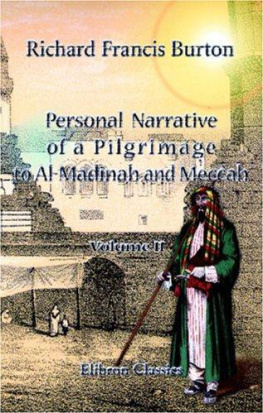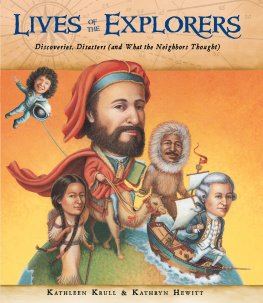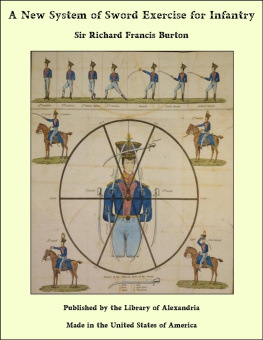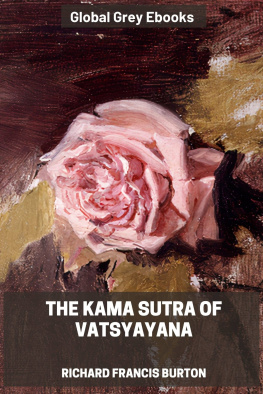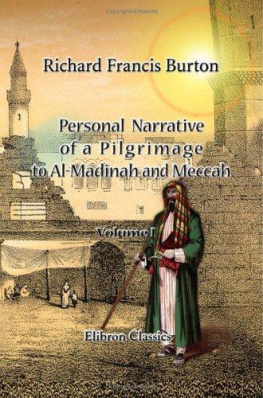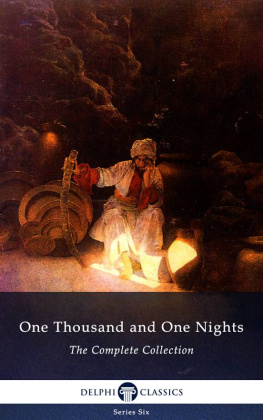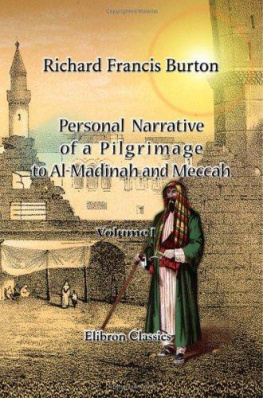The Project Gutenberg EBook of Personal Narrative of a Pilgrimage to Al-Madinah & Meccahby Sir Richard Francis Burton(#18 in our series by Sir Richard Francis Burton)
Copyright laws are changing all over the world. Be sure to check thecopyright laws for your country before downloading or redistributingthis or any other Project Gutenberg eBook.
This header should be the first thing seen when viewing this ProjectGutenberg file. Please do not remove it. Do not change or edit theheader without written permission.
Please read the "legal small print," and other information about theeBook and Project Gutenberg at the bottom of this file. Included isimportant information about your specific rights and restrictions inhow the file may be used. You can also find out about how to make adonation to Project Gutenberg, and how to get involved.
**Welcome To The World of Free Plain Vanilla Electronic Texts**
**eBooks Readable By Both Humans and By Computers, Since 1971**
*****These eBooks Were Prepared By Thousands of Volunteers!*****
Title: Personal Narrative of a Pilgrimage to Al-Madinah & Meccah
Author: Sir Richard Francis Burton
Release Date: November, 2003 [EBook #4658][Yes, we are more than one year ahead of schedule][This file was first posted on June 12, 2002]
Edition: 10
Language: English
*** START OF THE PROJECT GUTENBERG EBOOK, PERSONAL NARRATIVE OF A PILGRIMAGE TO AL-MADINAH & MECCAH ***
Scanned and proofread by William Thierens and Robert Sinton
PERSONAL NARRATIVE OF A PILGRIMAGE TO AL-MADINAH & MECCAH
BY
CAPTAIN SIR RICHARD F. BURTON,
K.C.M.G., F.R.G.S., &c., &c., &c.
EDITED BY HIS WIFE, ISABEL BURTON.
Our notions of Mecca must be drawn from the Arabians; as no unbelieveris permitted to enter the city, our travellers are silent.Gibbon, chap.50.
MEMORIAL EDITION.
IN TWO VOLUMES
VOLUME II.
[p.xii]
[Arabic]
Dark and the Desert and Destriers me ken,
And the Glaive and the Joust, and Paper and Pen.
Al-Mutanabbi
PART II.
AL-MADINAH.
(Continued.)
[p.1]A PILGRIMAGE
TO
AL-MADINAH AND MECCAH.
CHAPTER XXI.
THE PEOPLE OF AL-MADINAH.
AL-MADINAH contains but few families descended from the ProphetsAuxiliaries. I heard only of four whose genealogy is undoubted. Thesewere,
1. The Bayt al-Ansari, or descendants of Abu Ayyub, a most noble racewhose tree ramifies through a space of fifteen hundred years. They keepthe keys of the Kuba Mosque, and are Imams in the Harim, but the familyis no longer wealthy or powerful.
2. The Bayt Abu Jud: they supply the Harim with Imams andMuezzins.[FN#l] I was told that there are now but two surviving membersof this family, a boy and a girl.
3. The Bayt al-Shaab, a numerous race. Some of the members travelprofessionally, others trade, and others are employed in the Harim.
4. The Bayt al-Karrani, who are mostly engaged in commerce.
There is also a race called Al-Nakhawilah,[FN#2] who,
[p.2]according to some, are descendants of the Ansar, whilst othersderive them from Yazid, the son of Muawiyah: the latter opinion isimprobable, as the Caliph in question was a mortal foe to Alis family,which is inordinately venerated by these people. As far as I couldascertain, they abuse the Shaykhayn (Abu Bakr and Omar): all myinformants agreed upon this point, but none could tell me why theyneglected to bedevil Osman, the third object of hatred to the Shiahpersuasion. They are numerous and warlike, yet they are despised by thetownspeople, because they openly profess heresy, and are moreover ofhumble degree. They have their own priests and instructors, althoughsubject to the orthodox Kazi; marry in their own sect, are confined tolow offices, such as slaughtering animals, sweeping, and gardening, andare not allowed to enter the Harim during life, or to be carried to itafter death. Their corpses are taken down an outer street called theDarb al-JanazahRoad of Biersto their own cemetery near Al-Bakia. Theydress and speak Arabic, like the townspeople; but the Arabs pretend todistinguish them by a peculiar look denoting their degradation: it isdoubtless the mistake of effect for cause, about all such
Tribes of the wandering foot and weary breast. number of reports are current about the horrid
[p.3]customs of these people, and their community of women[FN#3] withthe Persian pilgrims who pass through the town. It need scarcely besaid that such tales coming from the mouths of fanatic foes are not tobe credited. I regret not having had an opportunity to become intimatewith any of the Nakhawilah, from whom curious information might beelicited. Orthodox Moslems do not like to be questioned about suchhateful subjects; when I attempted to learn something from one of myacquaintance, Shaykh Ula al-Din, of a Kurd family, settled atAl-Madinah, a man who had travelled over the East, and who spoke fivelanguages to perfection, he coldly replied that he had never consortedwith these heretics. Sayyids and Sharifs,[FN#4] the descendants of theProphet, here abound. The Benu Hosayn of Al-Madinah have theirhead-quarters at Suwayrkiyah:[FN#5] the former place contains six orseven families; the latter, ninety-three or ninety-four. Anciently theywere much more numerous, and such was their power, that for centuriesthey retained charge of the Prophets tomb. They
[p.4]subsist principally upon their Amlak, property in land, for whichthey have title-deeds extending back to Mohammeds day, and Aukaf,religious bequests; popular rumour accuses them of frequent murders forthe sake of succession. At Al-Madinah they live chiefly at the Hosh IbnSaad, a settlement outside the town and south of the Darb al-Janazah.There is, however, no objection to their dwelling within the walls; andthey are taken to the Harim after death, if there be no evil reportagainst the individual. Their burial-place is the Bakia cemetery. Thereason of this toleration is, that some are supposed to be Sunni, ororthodox, and even the most heretical keep their Rafz[FN#6] (heresy) aprofound secret. Most learned Arabs believe that they belong, like thePersians, to the sect of Ali: the truth, however, is so vaguely known,that I could find out none of the peculiarities of their faith, till Imet a Shirazi friend at Bombay. The Benu Hosayn are spare dark men ofBadawi appearance, and they dress in the old Arab style still affectedby the Sharifs,a Kufiyah (kerchief) on the head,[FN#7] and a Banish, along and wide-sleeved garment resembling our magicians gown, thrown overthe white cotton Kamis (shirt): in public they always carry swords,even when others leave weapons at home. There are about two hundredfamilies of Sayyid Alawiyah,descendants of Ali by any of his wives butFatimah, they bear no distinctive mark in dress or appearance, and areeither employed at the
[p.5]temple or engage at trade. Of the Khalifiyah, or descendants ofAbbas, there is, I am told, but one household, the Bayt Al-Khalifah,who act as Imams in the Harim, and have charge of Hamzahs tomb. Somedeclare that there are a few of the Siddikiyah, or descendants from AbuBakr; others ignore them, and none could give me any information aboutthe Benu Najjar.
The rest of the population of Al-Madinah is a motley race composed ofoffshoots from every nation in Al-Islam. The sanctity of the cityattracts strangers, who, purposing to stay but a short time, becomeresidents; after finding some employment, they marry, have families,die, and are buried there with an eye to the spiritual advantages ofthe place. I was much importuned to stay at Al-Madinah. The only knownphysician was one Shaykh Abdullah Sahib, an Indian, a learned man, butof so melancholic a temperament, and so ascetic in his habits, that hisknowledge was entirely lost to the public. Why dost thou not, said myfriends, hire a shop somewhere near the Prophets Mosque? There thou wilteat bread by thy skill, and thy soul will have the blessing of being onholy ground. Shaykh Nur also opined after a short residence atAl-Madinah that it was bara jannati Shahr, a very heavenly City, andlittle would have induced him to make it his home. The present rulingrace at Al-Madinah, in consequence of political vicissitudes, is theSufat,[FN#8] sons of Turkish fathers by Arab mothers. These half-castesare now numerous, and have managed to secure the highest and mostlucrative offices. Besides Turks, there are families originally fromthe Maghrib, Takruris, Egyptians in considerable numbers, settlers fromAl-Yaman and other parts of Arabia, Syrians, Kurds, Afghans,Daghistanis from the Caucasus, and a few JawisJava Moslems. The Sindis,I was told, reckon about one hundred families, who are exceedinglydespised for their
Next page
